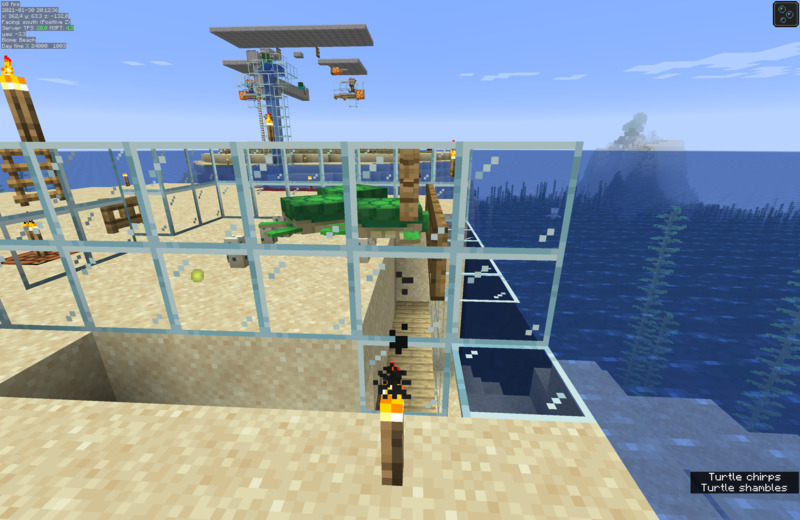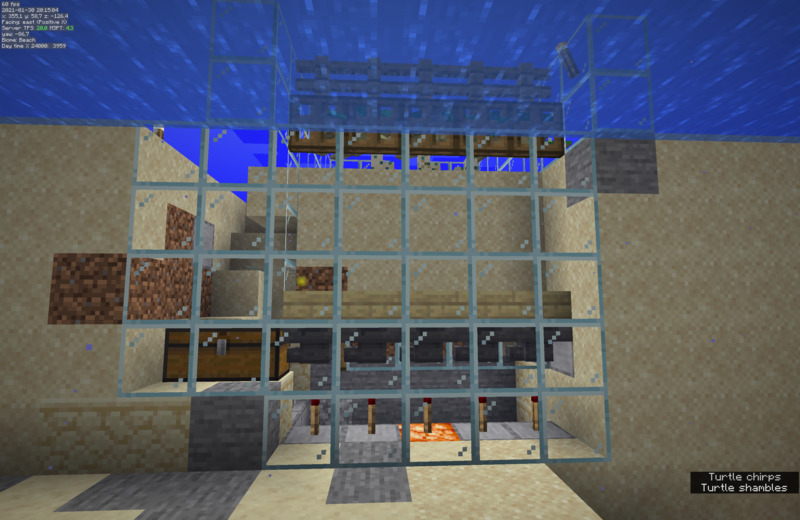Early Game Turtle Farm
Early game turtle farms are extremely useful, for a short period of time.
The Turtle Shell helmet gives an additional 10 seconds of time under water before the player starts to take damage. This makes diving into shipwrecks much easier - and early game, the loot from these shipwrecks is very useful.
Shipwrecks generate with up to 3 loot chests containing various seeds (sometimes bamboo! which can be very welcome), iron (very common) or other precious ores and Treasure Maps, leading to more useful items (the treasure is always at chunk coordinate 9, btw).
Later in the game, I’ve rarely found a use for turtle shells. An enchanted diamond or netherite helmet is a better choice; and I personally do not think that a Potion of the Turtle Master is worth the inventory slot.
I recommend building this right at the start of the game, or not build it at all.
Well Known Designs
Turtle farming has been on the minecraft wiki for a long time, and you’ll find plenty of videos on youtube using this design.
Then there is Rays Works Easy AFK Turtle Shell Farm, which is fully automatic but in my opinion not a good choice early game. I do like that it kills the turtles though - my starter base is usually near if not in the spawn chunks, and I don’t like flooding the spawn chunks with turtles.
The Pathfinding Approach
I like using path finding in my farms, and turtle babies attempt to path find to the nearest water source block with sky light access. You arrange the layout so that the water source blocks on one side are always the nearest for every block inside the enclosure, and then you stop the migration to the sea with trap doors, dropping the baby turtles down at least 2 blocks.
The baby turtles sometimes climb on each other, and when they grow up they can glitch out of the kill chamber if you use less than that.
The hoppers below the slabs will pick up the scutes and the seagrass.
Building the farm
Turtles will lay their eggs only on their home beach. If you trap non-local turtles in your enclosure, they will never lay eggs. I suggest finding a nice turtle beach and breeding 2 turtles, then building your farm around those first eggs. If you trap the parent turtles, one of them may be non-local and you’ll have to kill it.
Once you have your turtle eggs, light up the area and build an enclosure around it. The interior dimensions are not that important, I like using 3 turtles in a 5x5 space but that is just preference. The important bit is that on one side, you need an additional block and then water, and on all other sides the water must be further away.

The third turtle is very useful: with turtles, the mommy turtle starts looking for a place to bury their eggs, but the other one resets right away and can be fed immediately - and it will breed at once with the third turtle. Twice the eggs with no additional waiting.
In the enclosure, all non-sand blocks should be replaced with sand. I also like to replace the layer below with some non-gravity block but that is not strictly necessary.
If you still need additional turtles, put a temporay block above the drop until you have enough.

In the front image, the redstone torches below the hoppers are so I can turn them off if I want to - this particular farm is in my spawn chunks.
Using the farm
Turtle eggs need random ticks to crack, and their best chance to crack is in a brief window of time before dawn (21600 to 22550 ticks, around 48 seconds according to the wiki).
So you can not sleep at night when trying to breed turtles, you need to stay up through the night, although you can sleep just before the sun goes up if you are afraid of phantoms.
You also have to stay in the area - only chunks whose center is within 128 blocks of a player are ticked.
And once the turtles are hatched, the baby turtles need to grow up. This takes one minecraft day AKA 20 minutes, and again you have to stay in the area - the chunk needs to be ticked for animals (or plants, for that matter) to grow.
You could AFK this, personally I just build my starter base within tick distance of my turtle farm.